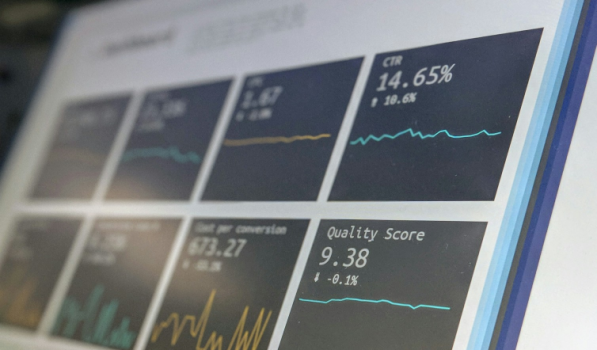Get a Free WorkTrek Demo
Let's show you how WorkTrek can help you optimize your maintenance operation.
Try for freeMotivating your maintenance team can improve efficiency and success in your operations by enhancing employee engagement. Maintenance managers play an important role in this by being clear on work expectations, providing an enabling environment, valuing contributions, and ensuring a path for growth.
A well-motivated team can increase productivity, reduce downtime, and increase job satisfaction. Team morale is a key factor in achieving these goals.
Having all the tools and equipment needed for maintenance tasks is crucial, as lacking supplies can hinder work efficiency. Clear communication, recognition of hard work, and growth opportunities are key strategies that can significantly impact.
Creating a positive atmosphere where team members feel valued and heard is essential. Self-ownership can also be pivotal, as giving employees control over their roles fosters a sense of responsibility and engagement.
Tools like maintenance software and an open-door policy can further boost morale and efficiency.
Implementing these strategies can help you build a dedicated and motivated maintenance team. This will benefit your team and improve your organization’s overall performance.
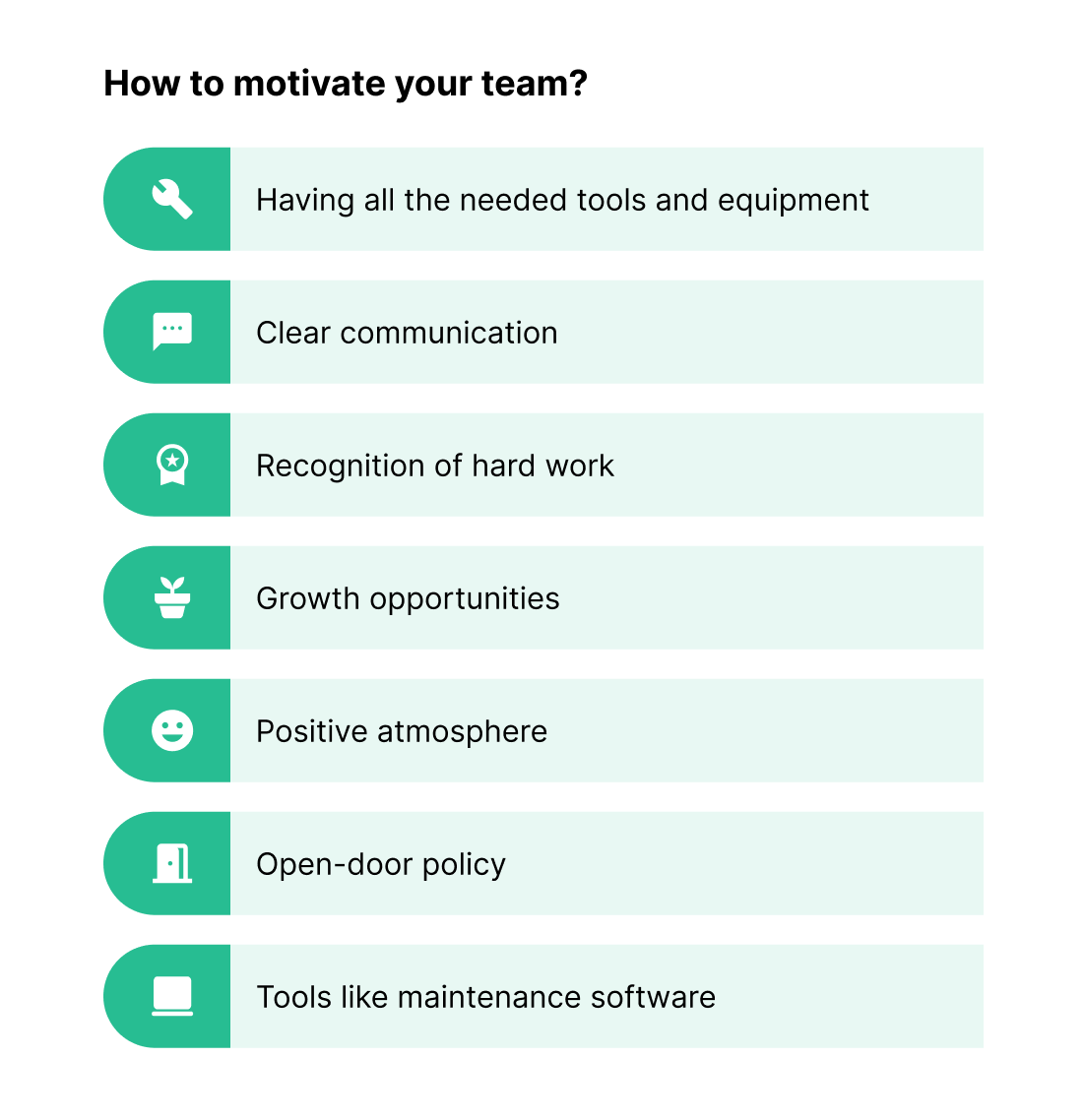
Source: WorkTrek
Understanding Team Dynamics
Motivate your maintenance crew to focus on team dynamics, analyze team strengths and weaknesses, promote effective communication, and foster a positive team culture.
Analyzing Team Strengths and Weaknesses
Start by identifying what your team does well and what needs improvement. Use tools like SWOT analysis to evaluate strengths, weaknesses, opportunities, and threats. Understanding these aspects can positively impact team morale.
Encourage team members to share their thoughts on individual and collective skills. This builds trust and provides valuable insights into areas where the team can grow.
Focus on professional development to bolster weaknesses while leveraging existing strengths.
Regular evaluations can help track progress and make necessary adjustments. Ensuring successful maintenance operations requires motivating and empowering staff through clear expectations, a supportive environment, and continuous training.
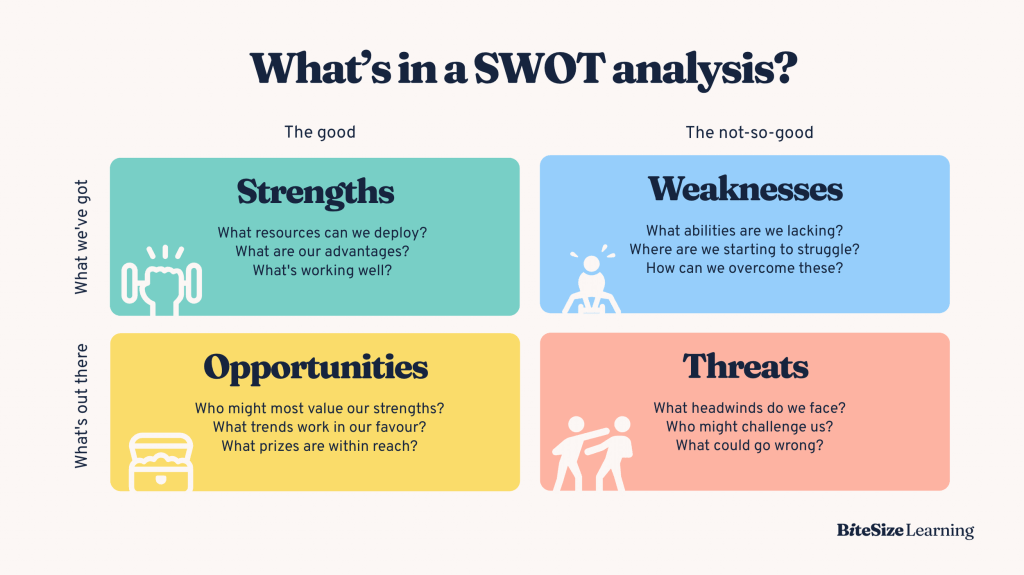
Source: BiteSize Learning
Promoting Effective Communication
Clear and open communication is key to a functioning team. Hold regular team meetings to discuss progress, challenges, and upcoming tasks, which can significantly boost employee engagement.
Use tools like instant messaging apps or collaboration platforms to keep everyone connected. Encourage feedback and make sure everyone feels heard.
Effective communication also includes listening. Make sure you understand your team’s concerns and address them promptly.
Open lines of communication can prevent misunderstandings and ensure the team works smoothly together. Defining tasks and setting expectations for maintenance technicians can enhance team efficiency.
Fostering a Team Culture for Maintenance Technicians
A positive team culture can make your team more motivated and productive. Create an atmosphere of trust and respect.
Celebrate individual and team successes to boost morale. Small rewards or public recognition can go a long way.
Make sure the team understands shared goals and works together towards them. Team-building activities can also help strengthen bonds among team members.
Promote transparency, mutual respect, and cooperation to create a thriving team environment.
Focusing on these aspects can help you build a well-rounded and motivated maintenance team. Explore resources on team dynamics and motivating maintenance staff for more ideas.
Setting Clear Goals and Expectations
Clear goals and expectations are crucial for the success and motivation of your maintenance team. These goals must be achievable and backed by accountability mechanisms to ensure everyone stays on track. Providing the necessary tools and resources is essential for quality maintenance work.
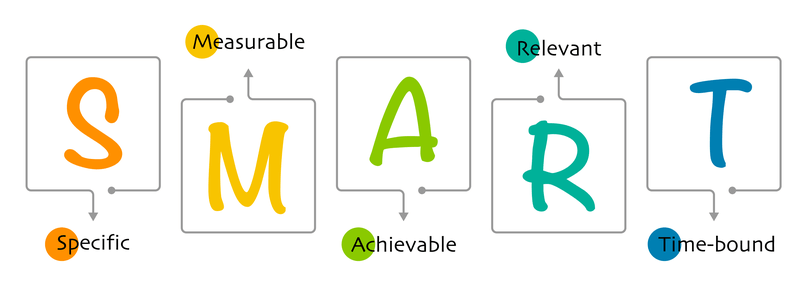
Source: SnackNation
Establishing Achievable Targets for Maintenance Operations
Setting achievable targets helps keep team members focused and motivated. Setting clear and achievable targets can also improve employee engagement by providing a sense of direction and purpose. Start by identifying specific, measurable goals that align with your overall objectives. These targets should be SMART:
- Specific
- Measurable
- Attainable
- Relevant
- Time-bound
For example, instead of saying, “Improve equipment maintenance,” you could set a target like “Reduce equipment downtime by 15% in the next six months.” This gives a clear and measurable goal. Regularly review and update these targets to keep them relevant and challenging.
Building Accountability Mechanisms
Accountability ensures that each team member takes ownership of their tasks. One way to do this is by assigning clear responsibilities and deadlines. Use tools like maintenance software to track progress and set reminders.
Hold regular meetings to discuss achievements and areas for improvement. Publicly recognizing individual and team successes can also build a culture of accountability. If someone consistently misses targets, have one-on-one discussions to identify challenges and offer support.
Establishing individual and _team-based accountability helps maintain transparency and trust within the team.
Leveraging the Right Incentives
Choosing the right incentives for your maintenance team, driven by employee motivation, can significantly drive continuous improvements and organizational success. Balancing monetary and non-monetary rewards and tailoring them to individual needs for maximum impact is essential.

Source: WorkTrek
Monetary versus Non-Monetary Rewards
Everyone likes cash. Monetary rewards, such as bonuses and raises, can be powerful motivators. They provide immediate financial benefits, which can boost morale and productivity. Monetary rewards can significantly enhance team morale by recognizing and valuing employees’ hard work.
However, money isn’t always the only motivator. Non-monetary rewards like extra time off, recognition, or professional development opportunities can be equally impactful.
Set Goals
Consider setting up a system where top performers receive bonuses for meeting or exceeding goals. Additionally, offering gift cards, vouchers, or other small monetary perks can keep motivation high without significant costs.
Non-monetary rewards can include public recognition in team meetings, certifications, or additional training. These rewards can help build a positive work culture and encourage long-term commitment. Mixing both types of rewards ensures a well-rounded approach to team motivation.
Customizing Incentives to Individual Needs
Understanding your team members’ preferences is important in offering effective incentives. Not everyone values the same things so that personalized rewards can lead to better outcomes.
It helps to get to know your team members. Start by getting to know each team member’s motivations.
Some may prefer financial bonuses, while others value flexible working hours or professional development opportunities. To gather this information, conduct surveys or have one-on-one conversations.
Tailoring Incentives
Once you have this insight, tailor your incentives to meet these needs. For instance, offer additional training for those seeking career advancement or family-related perks for those with children.
This personalized approach shows that you care about your team’s needs and can result in higher satisfaction and retention.
Customizing incentives creates a more engaged and motivated team that feels valued and understood. This strategy can significantly boost overall performance and job satisfaction.
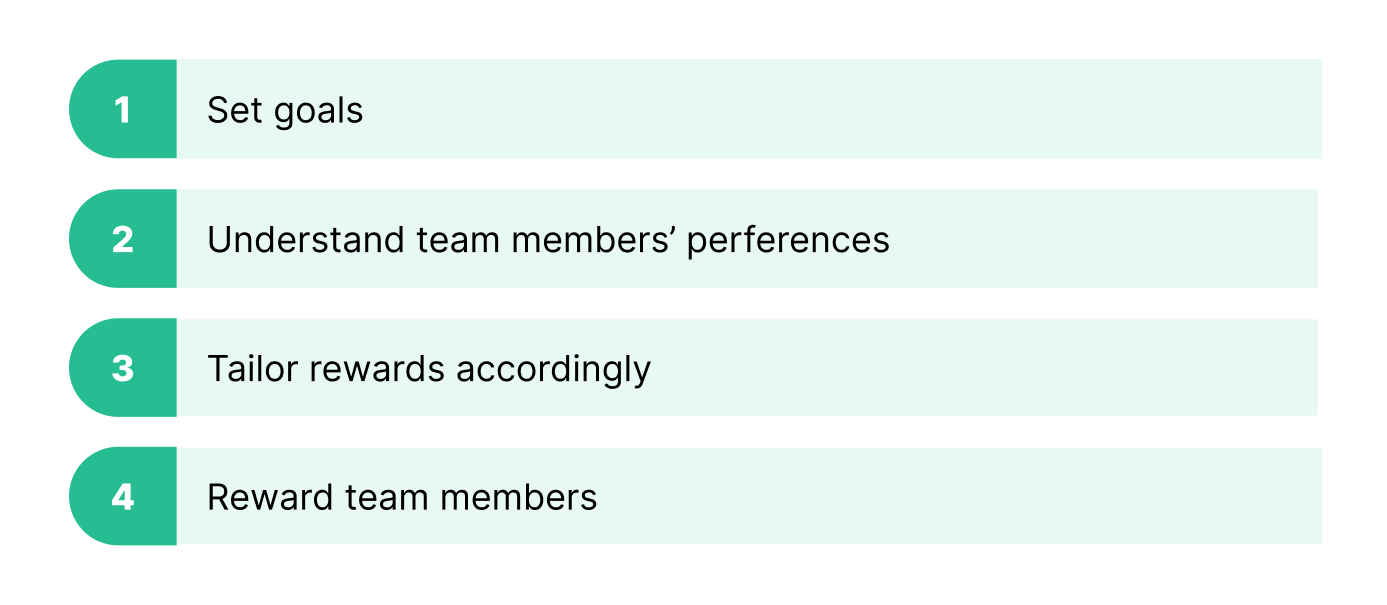
Source: WorkTrek
Investing in Training and Development
Provide your maintenance team with proper training programs and development opportunities. This can improve their technical skills, enhance their leadership abilities, and ensure they follow safety protocols.
Technical Skill Development
Your team needs up-to-date technical skills to manage modern equipment. By offering regular cross-training sessions, you enable team members to learn new techniques and take on different roles within the department.
This broadens their skill set and makes the workflow more flexible. Online courses and workshops can be beneficial. Encouraging continuous learning and professional development helps your team acquire new skills, keeping them motivated and empowered.
Continuous learning opportunities can also significantly improve employee engagement.
Encourage hands-on training and provide access to quality learning materials. Simulation software can offer real-world problem-solving scenarios, allowing your team to practice and refine their skills without consequences.
Leadership and Management Training
Investing in leadership training can help your team members take on supervisory roles. Provide courses on team management, conflict resolution, and effective communication. These skills allow them to lead projects and mentor junior staff.
Leadership training can also boost morale and job satisfaction. When team members see a clear path for career advancement, they are more likely to be motivated. Consider setting up mentorship programs where experienced leaders guide newer employees.
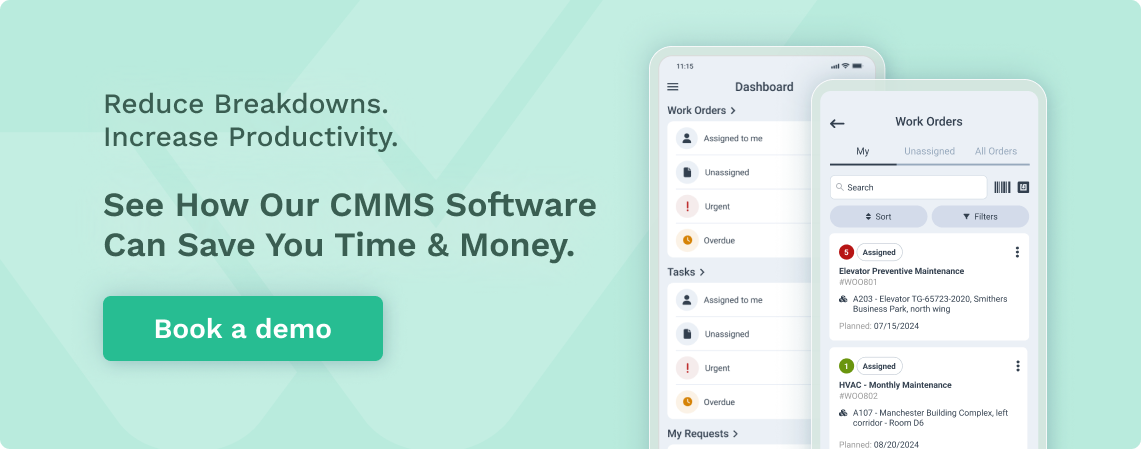
Safety and Compliance Education
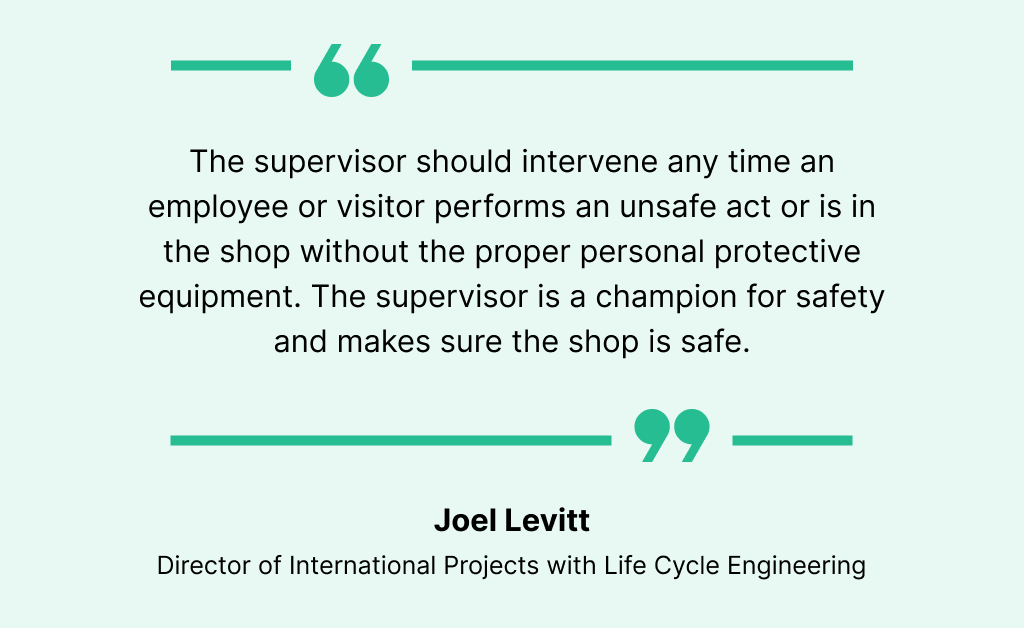
Illustration: WorkTrek / Quote: Industrial Distribution
Safety and compliance are vital in a maintenance environment. Regular safety training ensures that all team members know the latest regulations and best practices, reducing the risk of accidents and equipment damage.
Implement routine safety drills to keep procedures fresh in mind. Provide easy access to safety manuals and compliance guidelines. This proactive approach fosters a culture of safety and responsibility within your team, ensuring everyone knows their role in maintaining a safe workplace.
Giving your team the proper training and development opportunities can significantly impact their performance and satisfaction. Technical skill enhancement, leadership training, and safety education are key areas to focus on for long-term success.
Implementing Effective Tools and Equipment
Using the right tools and ensuring they are up-to-date can significantly enhance the productivity and morale of your maintenance team. Investing in modern technology and maintaining equipment properly are key strategies.
Upgrading to Modern Technology
Switching to newer tools can improve efficiency. For instance, consider adopting maintenance software that helps track tasks and inventory. This software can save time and reduce errors. Digital diagnostic tools can help identify issues quickly, leading to faster resolutions.
Advanced machinery with automated features can also ease the workload. For example, automated lubrication systems ensure equipment operates smoothly with less manual intervention. These improvements can make your team’s job more accessible and more satisfying.
Advanced tools and technology can also enhance employee engagement by making their work more engaging and efficient.
Regular Maintenance and Inspection
Regular upkeep of tools and equipment is essential. Scheduling inspections can prevent unexpected breakdowns and extend the lifespan of machinery.
However, avoid overloading the maintenance schedule with too much preventive work, which can be counterproductive.
A preventive maintenance checklist can help ensure that all parts are inspected regularly. Routine checks for wear and tear can identify potential issues before they become significant problems. This not only keeps equipment in top shape but also ensures safety for your team.
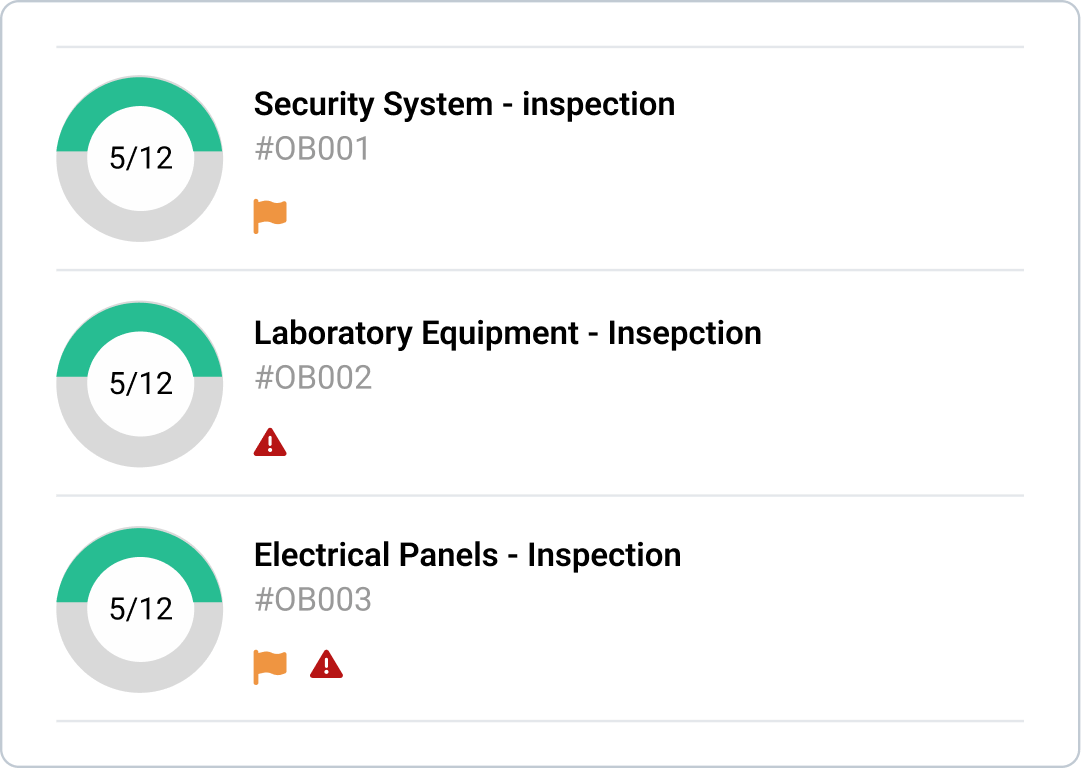
Source: WorkTrek
Measuring Performance and Providing Feedback
To keep your maintenance team motivated, set clear performance metrics and provide constructive feedback regularly. This will help keep everyone aligned with the team’s goals and promote continuous improvement.
Setting up Performance Metrics
Setting clear and realistic goals is the first step. Metrics such as response time to maintenance requests, number of tasks completed on time, and equipment downtime are valuable measures.
Track these systematically can help improve your maintenance operations. Implementing a Computerized Maintenance Management System (CMMS) helps keep accurate records. Clear performance metrics can also improve employee engagement by helping them stay focused and motivated toward their goals.
Review these metrics regularly to identify areas for improvement. This will help you make data-driven decisions that enhance the team’s efficiency.
Constructive Feedback Techniques
Constructive feedback is crucial for team improvement. Always provide feedback in a timely and respectful manner. Start by acknowledging the team’s successes and then address areas needing improvement.
Use one-on-one meetings to give personalized feedback. Be specific about what needs to improve and offer actionable steps. Incorporating a feedback loop where team members can voice their concerns or suggestions can also boost morale.
Encourage an open-door policy, which allows team members to feel comfortable discussing their performance and seeking advice. This fosters a culture of continuous learning and growth.
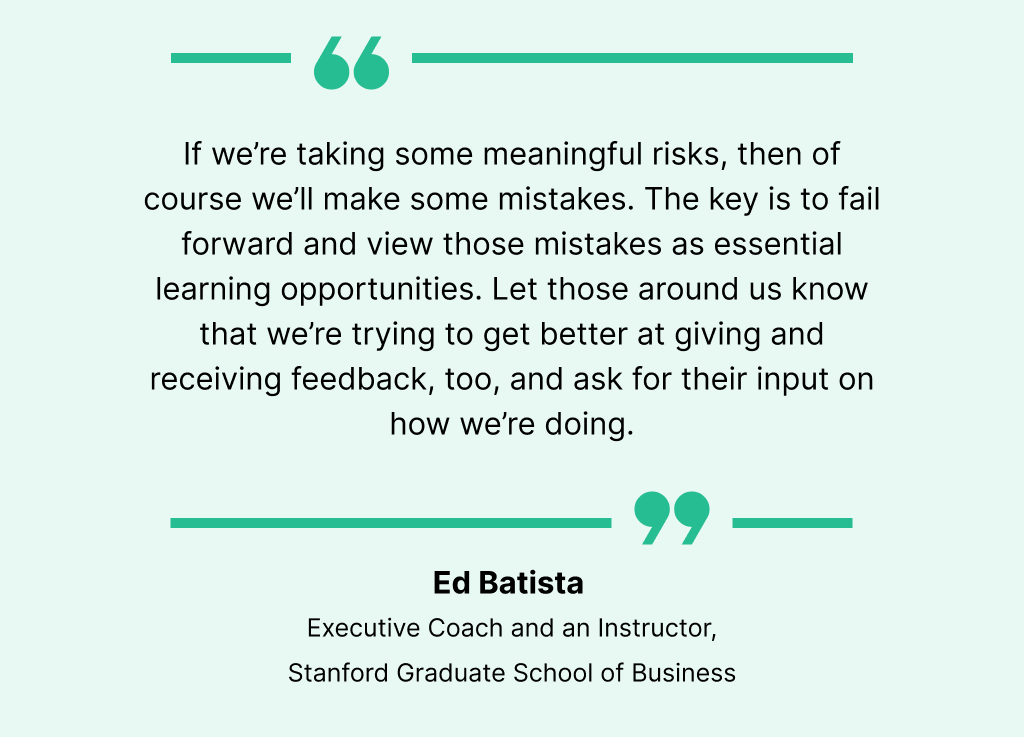
Illustration: WorkTrek / Quote: ThoughtExchange
Encouraging Ownership and Empowerment
Fostering a sense of ownership and empowering your maintenance team can lead to higher job satisfaction and increased productivity. Here’s how to delegate responsibility and promote autonomy in decision-making.
A maintenance manager should lead the team as a mini-business unit, focusing on transforming the crew into a high-performing team.
Delegating Responsibility
Giving team members specific tasks and roles fosters accountability. When you assign responsibilities, ensure they align with each person’s skills and strengths. This can increase their confidence and make them feel more invested in their work. Additionally, delegating responsibility can significantly improve employee engagement by giving them ownership of tasks.
List of Key Actions:
- Identify strengths: Match tasks to team members based on their strengths.
- Set clear expectations: Clearly outline what is expected for each task.
- Provide necessary resources: Ensure team members have the necessary tools and training.
Regularly review progress and provide feedback. This helps employees understand their contributions and areas for improvement.
Autonomy in Decision Making
Allowing your maintenance team to make decisions can significantly boost their motivation. Trust them to solve problems and make choices about their tasks.
Steps to Foster Autonomy:
- Encourage problem-solving: Let team members approach and solve issues on their own.
- Permit flexibility: Allow them to choose the methods and tools they prefer.
- Support risk-taking: Encourage innovation by supporting calculated risks.
Make it clear that their opinions and decisions are valued. Hold regular meetings where team members can voice their ideas and feedback. This empowers them and leads to innovative solutions that benefit the entire team.
You create a more motivated and engaged maintenance team by fostering responsibility and autonomy.
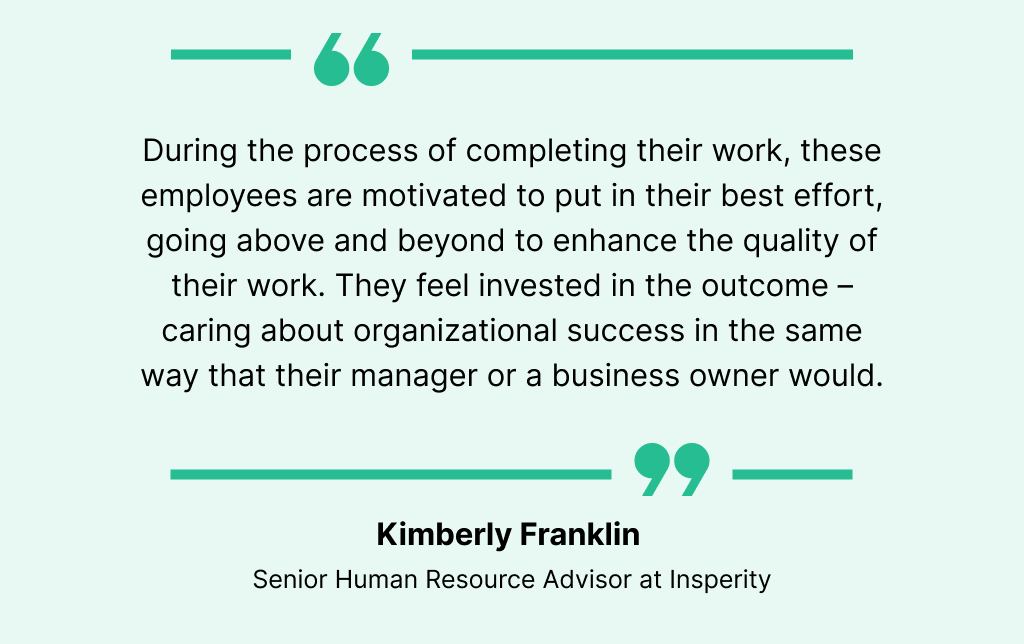
Illustration: WorkTrek / Quote: Insperity
Facilitating Work-Life Balance
A good work-life balance is important for your maintenance team. When staff members have time for personal activities, they return to work refreshed and productive.
Flexible Schedules
Allow your team to have flexible work hours. This means letting them choose when to start and end their days as long as the work gets done. Flexible schedules can reduce burnout and improve overall happiness.
Remote Work Options
Provide remote work options for tasks that can be done off-site. This allows your team to handle personal errands without affecting their job responsibilities.
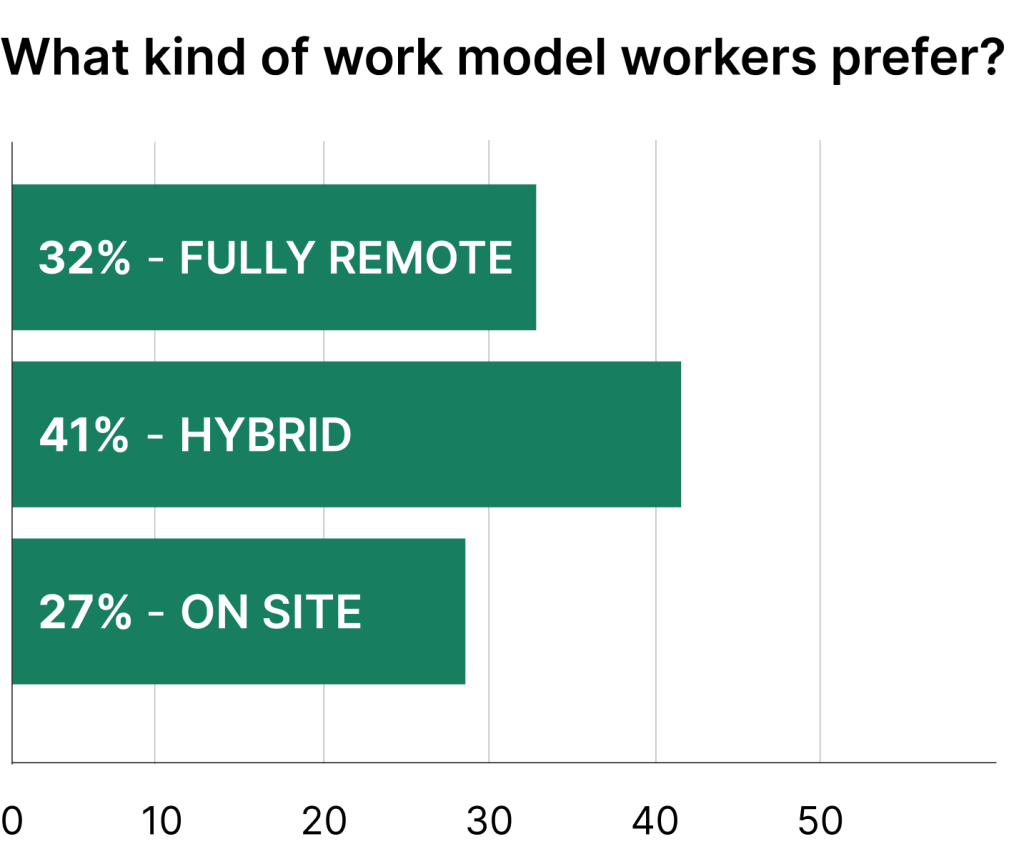
Illustration: WorkTrek / Data: Hubspot
Clear Expectations
Being clear about work expectations helps your team manage their time better. Ensure they know what is expected of them and how to prioritize tasks. This can help prevent stress and frustration.
Measures to Support Balance
There are several steps you can take to create a well-balanced workplace:
Flexible Schedules: Reduces burnout and improves happiness. Flexible schedules can also significantly boost team morale by allowing employees to manage their personal and professional lives better.
Remote Work Options: These options allow the handling of personal tasks and can improve team morale by providing the flexibility to work from home.
Clear Expectations: This can reduce and prevent stress and frustration for the team.
Encourage Breaks: Encourage your team to take regular breaks during the day. Short breaks can improve focus and job satisfaction.
Promote Physical Activity: Support physical fitness by offering gym memberships or organizing team sports. Physical activity can boost energy, reduce stress, and enhance overall well-being.
Provide Mental Health Resources: Offering access to mental health resources can help your team manage stress and maintain a healthy work-life balance. Resources might include counseling services or stress management workshops.
You foster a more engaged and efficient maintenance team by facilitating work-life balance. This leads to a happier, healthier workforce.
Recognizing and Celebrating Successes
Regularly recognizing and celebrating successes is essential to keeping your maintenance team motivated when team members feel appreciated, their engagement and dedication increase. Recognition programs can also significantly boost team morale.
One effective method is to establish a Recognition Program. This can include quarterly awards for outstanding performance, personalized certificates, or small bonuses. Rewards give employees something to strive for and acknowledge their hard work.
Celebrate Success
Celebration Events can also boost morale. Hosting a monthly team lunch or an annual awards ceremony is a great way to celebrate achievements. These events create a sense of camaraderie and build a positive team culture.
Public acknowledgment is powerful. Highlight achievements on a company bulletin board or in a newsletter. This recognizes the individual and promotes a culture of excellence within your team.
Creating and sharing a Success Wall can also be very effective. This could be a physical wall in the office where team accomplishments are posted or a digital space on your company intranet. Seeing their work visually represented can motivate employees to continue performing well.
Feedback should always be positive and constructive. When recognizing achievements, be specific about what was done well. This reinforces desired behaviors and skills.
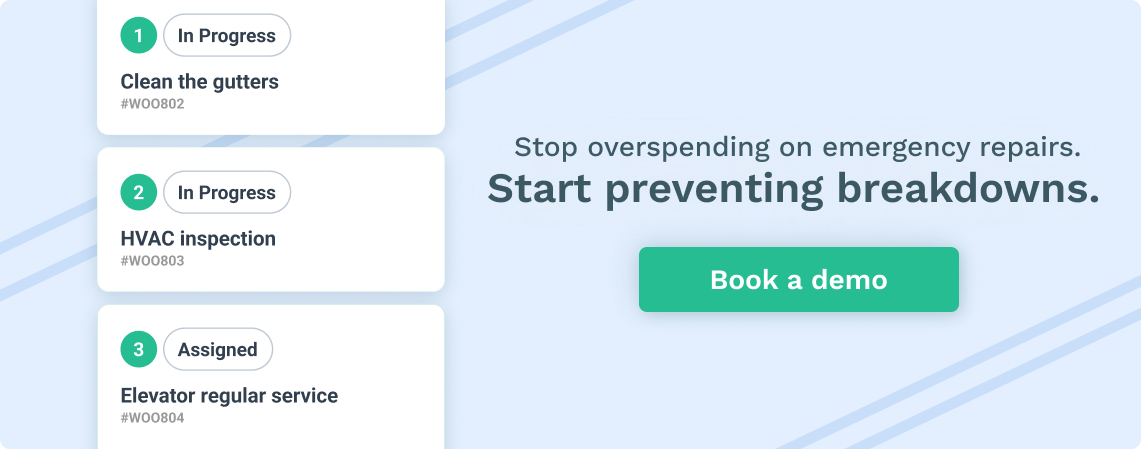
It’s also beneficial to involve the team in decision-making processes. This makes them feel valued and integral to the organization’s success.
Make recognition a regular part of your routine. Whether through formal awards or simple thank-you notes, consistent acknowledgment of your team’s efforts can lead to sustained motivation and engagement.
Maintaining Safe and Positive Work Environments
A positive working environment is essential for boosting morale and job satisfaction among your maintenance team. Ensure all team members have access to necessary tools and resources, which helps them do their job effectively.
Clear Communication: Consistently share information about workplace safety and procedures. When everyone knows what is expected, the workplace runs smoothly.
Proper Training: Offer regular training sessions on safety protocols. This keeps everyone updated on the latest safety standards.
Fair Policies: Implement fair and equitable policies. It’s important to be flexible and considerate of individual needs while maintaining clear guidelines.
Key Elements of a Safe and Positive Work Environment
- Clean Work Areas: Keep maintenance areas tidy and free from hazards.
- Protective Gear: Provide appropriate protective equipment and ensure its regular use.
- Open Door Policy: Foster an atmosphere where team members feel comfortable discussing concerns. A positive work environment can significantly improve employee engagement.
Benefits
- Increased Morale: A positive work environment boosts team morale and job satisfaction.
- Higher Productivity: Employees who feel safe and valued are more productive.
- Reduced Injuries: A safe workplace lowers the chance of accidents, saving time and resources.
Ensuring your team’s physical safety and emotional well-being can significantly impact their motivation and performance. For more strategies, refer to 7 Ways to motivate your maintenance team.
Enabling Continuous Improvement
To ensure your maintenance team excels, focus on enabling continuous improvement. Begin by fostering a culture where feedback is regular and constructive.
Create an Open Dialogue
Encourage team members to share their ideas. An open-door policy can make communication effortless.
Train Regularly
Provide both technical and soft skills training. This keeps the team updated with the latest industry practices and improves collaboration.
Celebrate Small Wins
Acknowledge improvements and accomplishments. Simple gestures of appreciation boost morale and motivate further effort.
Set Clear Goals
Establish clear, measurable objectives. When team members know what they are aiming for, their focus sharpens.
Use Technology
Invest in modern tools and technology. This can streamline maintenance tasks and increase efficiency.
Engage Employees
Actively involve the team in decision-making processes. This can lead to higher engagement and job satisfaction.
Monitor Progress
Regularly track and assess team performance. Use data to identify areas for improvement and to celebrate successes.
Encourage Problem-Solving
Promote a problem-solving mindset. Equip your team with the skills to identify and fix issues proactively.
Provide Growth Opportunities
Offer paths for career advancement. A clear pathway for growth motivates employees to stay and excel.
By implementing these strategies, you can create an environment where continuous improvement is a natural part of your team’s workflow. For more insights, consider exploring best practices in industrial maintenance.
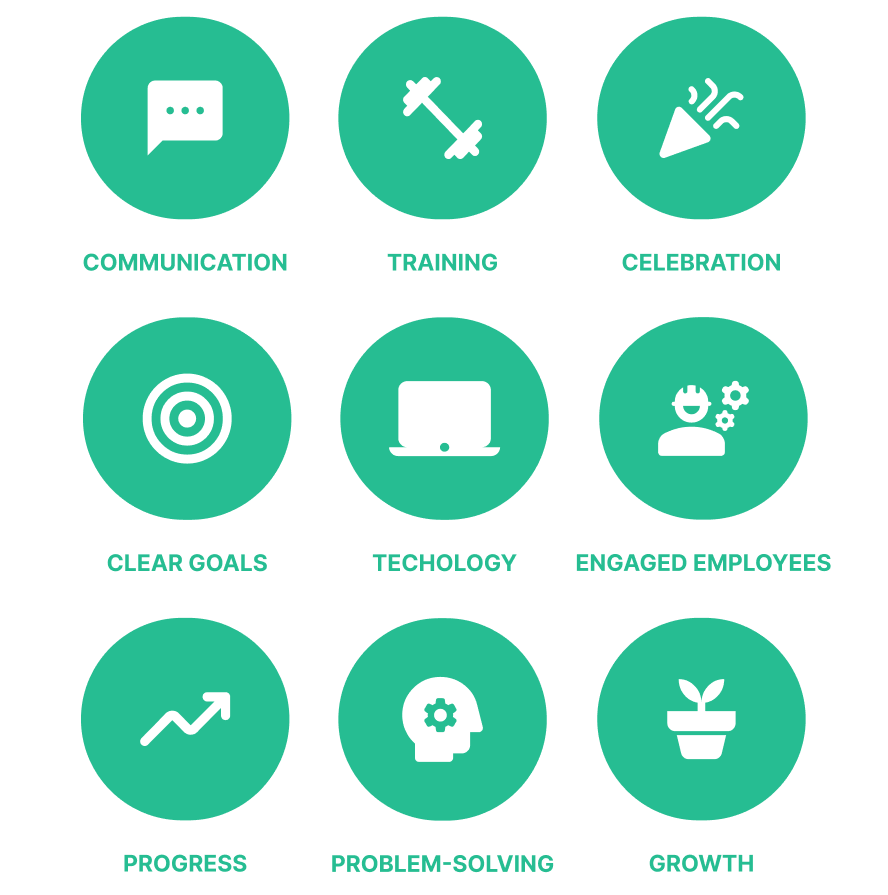
Source: WorkTrek
Frequently Asked Questions
This section covers important aspects of motivating your maintenance team, including strategies to boost productivity, inspire performance, create a positive work environment, and improve job satisfaction with clear points and actionable tips.
What are effective strategies for increasing productivity in a maintenance team?
Establish clear work expectations and goals to increase productivity. Implement new tools and technology, like maintenance management software, to streamline tasks. Review performance regularly and adapt practices as needed to keep the team efficient.
How can I inspire my maintenance staff to improve performance and efficiency?
Inspire your maintenance staff by setting a clear vision and providing regular feedback. Encourage open communication and actively involve team members in decision-making processes. Recognize and celebrate small and big successes to boost morale.
How can team leaders foster a positive work environment for maintenance crews?
Team leaders can foster a positive work environment by creating an atmosphere of respect and cooperation. Offer support and resources needed to perform tasks effectively. Promote teamwork and foster strong relationships among team members.
What are the key factors contributing to high job satisfaction among maintenance employees?
High job satisfaction often comes from fair compensation, work-life balance, and growth opportunities. Enable access to proper tools and training. Ensure that work expectations are clear and realistic to prevent burnout and disengagement.
How do recognition and rewards impact the morale of maintenance workers?
Recognition and rewards significantly impact morale. Simple gestures like “Employee of the Month” can boost motivation. Financial incentives or additional time off can also serve as powerful motivators.
What training and development opportunities can lead to greater engagement for maintenance teams?
Offering regular training sessions and development programs can lead to greater engagement. Encourage employees to gain certifications and attend workshops. Promote from within to show that there are growth opportunities in their careers.









